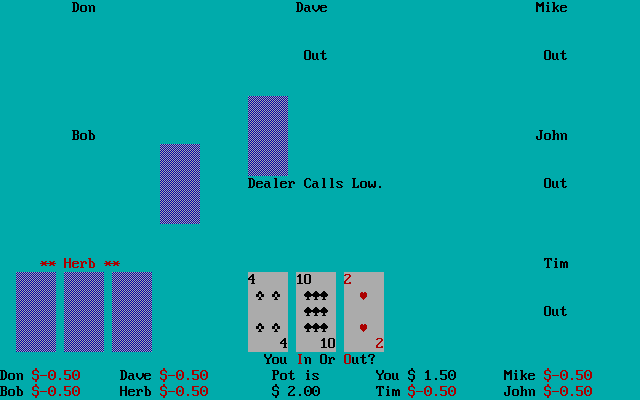Low Poker Card
So for example, hand #9 is known as a ‘Six-low’ because its highest card is a Six. Hand #5 is a ‘Seven-low’, and Hand #1 is an ‘Eight-low’. In poker slang, you distinguish between close low hands by going further down the ranks, so hand #9 would be called a ‘Six-Four low’, which beats hand #8, a ‘Six-Five low’.
Replay Poker recently launched two new poker variants: Seven Card Stud and Hi/Lo. Ready to dip your toes in the water? We have a guide for you to get started with Hi/Lo.

Starting hands
- Commonly, 5432A is considered the best, which does not disqualify straights and flushes for the low and allows an ace to be used either high or low. Thus, 5432A rules gives more opportunity for a player to.
- Low poker card is a crossword puzzle clue that we have spotted 10 times. There are related clues (shown below).
Until you get experienced, fold hands that aren’t connected.
Start with three low cards, three running cards, three suited cards, or pairs for the initial bet. You might want to raise the “bring in” bet if your hand is particularly attractive, or the majority of your opponents have medium to high cards showing.
Betting
Remember that in Fixed Limit poker, Third Street and Fourth Street are set at the low blind level. Because of this, it’s usually fine to call some action on the Fourth card if you get that far, providing you don’t whiff completely or any opponent raises with an obviously good card.
- An ace for your opponent is usually strong because it counts as both high and low.
- Be mindful that if players start with a low card and are dealt another low card, they may be well on their way to completing a low draw — or have at least a pair.
Observation is key
Keep a mental note of the folded cards. You’ll want to know exactly how many of your suit are left if you’re aiming for a flush. Not to mention if anyone else may have one! Also keep tabs on how many straight or pair cards are left which could hit you.
A rule of thumb is that most players fold on Third, Fifth, or Seventh Street. For most players, if their hand is good enough to take the fourth card, it’s usually all right to call another bet on the cheaper Fourth Street.
If you get to the sixth card, you should only have played on fifth street with a good understanding of your objectives for the pot. Pot odds should be attractive enough to take the final card.
Don’t get trapped looking for half!
Just like in Omaha Hi/Lo, shooting for half the pot with a draw is a very bad proposition.
The best you can hope for is a little more than your money back. Even if you do catch, you often get quartered or lose altogether. That’s not to say never, ever go for one side of the pot — sometimes it’s clear that you’re the only one who has a strong chance. Still, it is a situation you should avoid until you become experienced.

Looking for more information? We like Daniel Negreanu’s take on this format:
For basic rules on Seven Card Stud Hi/Lo, please read our Help Center article.
Low Hole
A variation on 7-card stud, where every player has at least one wild card...

Overview:
This is just like 7-Card Stud, but with an interesting system for wild cards. The lowest card that each individual player has face-down (aka 'in the hole') is wild for that player - as are cards of the same value. So if a player's face-down cards at the end of the hand are 7, 4, and 3, then all 3's in that player's hand are wild. (Note: Aces are always high compared to any other card for the purposes of determining the low-hold card.)
Now, notice that in 7-card stud, your last face-down card is the last card you receive. So if you're in the middle of the game, with 2 face down and 4 face-up cards, and your low face-down card is a 5, and you have two 5's face-up, then you have THREE wild cards! That's a good situation to be in. But that last face-down card could be a 2; then your 5's would cease to be wild. That's why there's the option to 'buy' your last card face-up; you can pay $2.00, for example, to have that last card be face-up instead of face-down, to protect a fragile multiple-wild-card situation. It sounds complicated in writing, but once you've played this game a few times, it'll make perfect sense!
Low Vision Poker Cards
Give this game a shot - it's definitely one of the most enjoyable games I know. Big hands tend to win, too - four of a kinds, straight flushes - I've even seen two five of a kinds go against each other! It's a blast...